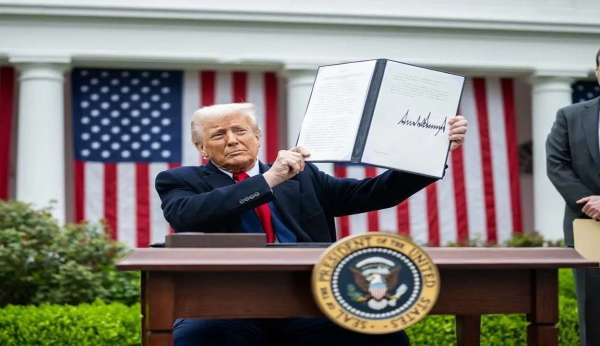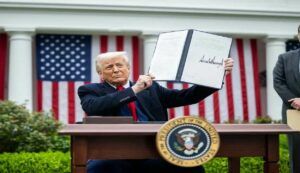
US: The Trump administration’s broad new tariffs on international trading partners, which include a 27% charge on imports from India, are expected to have an impact on a number of important industries, including solar PV modules, clothing, diamonds, and smartphones. Although the presidential order issued on April 2 permits exclusions for certain energy items, medicines, and key minerals, a deeper examination of the tariff lines and India’s top 100 exports shows that the relief is not very great.

Only the $4.4 billion in 2023–2024 exports of petroleum oils made from bituminous materials (not including crude) stand to gain from this. Interestingly, none of India’s major pharmaceutical exports to the US, which came to $8 billion in FY24, are excluded from the administration’s “discounted reciprocal tariffs.”
Cars and car components, as well as steel and aluminum products, are also exempt from the most recent duties; the second Trump administration had already declared levies on these items.
The majority of India’s leading pharmaceutical exports to the US, such as omeprazole, lansoprazole, phenytoin, phenobarbital, and several gastrointestinal and anticancer medications, are not included on the list of exemptions.
However, local exporters may benefit from some respite since the 27 percent duty imposed on India, which goes into effect on April 9, is far lower or equivalent to the tariffs imposed on other major pharmaceutical exporters in Asia, such as China (34 percent) and Japan (24%).
“We’ll be brainstorming and talking with our US colleagues soon. The final consumer will be charged any applicable tariffs. In the end, the tax would be passed on to Indian exporters, notwithstanding the first difficulties they face,” a top pharmaceutical representative told The Indian Express.
Additionally, India’s garment exports to the US, which topped $7 billion in FY24, are expected to be affected. Nonetheless, the 37 percent duty on Bangladesh and the 46 percent tax on Vietnam are probably going to provide Indian exporters a competitive advantage.
“Even though India’s tariffs have increased significantly, it appears that India has an advantage in the apparel industry, as our main rivals, China, Bangladesh, Vietnam, Cambodia, and Sri Lanka, have been hit with higher reciprocal tariffs by the United States,” stated Mithileshwar Thakur, secretary general of the Apparel Export Promotion Council (APEC).
However, Brazil, Turkey, and other EU nations that export clothing, including Italy, Germany, and Spain, benefit from the present Trump Tariff. However, considering the inherent strength of the Indian garment industry—including the existence of the whole value chain and the outstanding array of products it offers—my first conclusion is that it will ultimately benefit India, and we should prepare to take advantage of this chance,” Thakur said.
The increased tariffs would also affect India’s exports of diamonds to the United States, which exceeded $9 billion in FY24, as well as shipments of smartphones valued at over $5 billion and solar PV modules valued at almost $2 billion. Given that the US is a major market for solar modules and cellphones, the increased levies provide a serious obstacle. Vietnam is well-represented in both industries, however, so the tariff difference may provide India a competitive advantage.
A 25% tax on cars and auto components was announced by the Trump administration in late March, and it was scheduled to go into effect on April 3. The tariffs raise questions about India’s future expansion in North America as well as its $7 billion in car component exports to the US.
A 25% tax on steel and aluminum products was already announced, and it went into force on March 12. With exports reaching $2.8 billion over the same time period, the US was the biggest market for iron and steel goods, while only ranking sixth among destinations for India’s iron and steel exports, which were valued at $476 million in FY24.